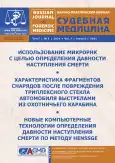New computer technologies to determine postmortem interval by the Henssge method
- Authors: Nedugov G.V.1
-
Affiliations:
- Samara State Medical University
- Issue: Vol 7, No 3 (2021)
- Pages: 152-158
- Section: Original study articles
- URL: https://journals.rcsi.science/2411-8729/article/view/122423
- DOI: https://doi.org/10.17816/fm406
- ID: 122423
Cite item
Full Text
Abstract
Background: The Henssge method is still the main thermometric method to determine postmortem interval. However, its existing software implementations are characterized by several disadvantages associated with copying simplified nomographic variants of the original mathematical models without any optimization attempts, as well as procedural imperfection in finding the roots of implicit functions. In this paper, methods are proposed for optimizing solutions to the Henssge mathematical models and determine their errors, as well as software application implementation. Aim: Optimization of the Henssge algorithm and development of a series of applications based on the obtained data, designed to determine postmortem interval. Material and methods: Methods for solving double exponential Henssge models and determining their errors based on computational mathematics and regression modeling using the least-squares method with subsequent implementation in the format of computer programs in C# language optimized. Results: The discrete nature of residual variance changes of the double exponential Henssge models intended to determine the postmortem interval according to rectal and cranioencephalic thermometry data under constant external temperature conditions is eliminated. The interval estimate determination of postmortem interval at any confidence probability is possible. The application program Warm Bodies HR was developed, which implements applied optimization methods. The application program Warm Bodies AHBG, designed to determine postmortem interval by the Henssge method in a single discrete decrease or increase conditions in the constant temperature of the external environment, including a change in the cooling conditions of the corpse, was developed. The search for the roots of implicit functions in programs is carried out using the Newton tangent method, which ensures continuous source data nature and eliminates errors associated with the need to round directly measured physical quantities. Conclusions: The developed programs are recommended for forensic medical expert practice to determine postmortem interval.
Full Text
##article.viewOnOriginalSite##About the authors
German V. Nedugov
Samara State Medical University
Author for correspondence.
Email: nedugovh@mail.ru
ORCID iD: 0000-0002-7380-3766
SPIN-code: 3828-8091
Scopus Author ID: 25947646500
ResearcherId: ABH-5590-2020
MD, Cand. Sci. (Med.), Assistant Professor
Russian Federation, 89 Chapaevskaya st., Samara, 443099References
- Cappelletti S, Bottoni E, Fiore PA, et al. Time since death in a case of simultaneous demise due to a single gunshot: an issue concerning the use of Henssge’s nomogram. Int J Legal Med. 2018;132(3):781–785. doi: 10.1007/s00414-017-1707-2
- Henssge C, Madea B. Estimation of the time since death in the early post-mortem period. Forensic Sci Int. 2004;144(2–3): 167–175. doi: 10.1016/j.forsciint.2004.04.051
- Madea B. Methods for determining time of death. Forensic Sci Med Pathol. 2016;12(4):451–485. doi: 10.1007/s12024-016-9776-y
- Schweitzer W, Thali MJ. Computationally approximated solution for the equation for Henssge’s time of death estimation. BMC Med Inform Decis Mak. 2019;19(1):201. doi: 10.1186/s12911-019-0920-y
- Henssge C. Death time estimation in case work. I. The rectal temperature time of death nomogram. Forensic Sci Int. 1988; 38(3–4):209–236. doi: 10.1016/0379-0738(88)90168-5
- Henssge C. Rectal temperature time of death nomogram: dependence of corrective factors on the body weight under stronger thermic insulation conditions. Forensic Sci Int. 1992; 54(1):51–66. doi: 10.1016/0379-0738(92)90080-g
- Potente S, Kettner M, Ishikawa T. Time since death nomographs implementing the nomogram, body weight adjusted correction factors, metric and imperial measurements. Int J Legal Med. 2019;133(2):491–499. doi: 10.1007/s00414-018-1928-z
- Hubig M, Muggenthaler H, Sinicina I, Mall G. Body mass and corrective factor: impact on temperature-based death time estimation. Int J Legal Med. 2011;125(3):437–444. doi: 10.1007/s00414-011-0551-z
- Hubig M, Muggenthaler H, Mall G. Influence of measurement errors on temperature-based death time determination. Int J Legal Med. 2011;125(4):503–517. doi: 10.1007/s00414-010-0453-5
- Noor M., Muhammad A., Bakar A. Enhancement of newton law of cooling method based on asante’s algorithm with henssge nomogram method in estimating the time of death. Int J Eng Technol. 2017;9(2):155–159. doi: 10.7763/IJET.2017.V9.962
- Althaus L, Henssge C. Rectal temperature time of death nomogram: sudden change of ambient temperature. Forensic Sci Int. 1999;99(3):171–178. doi: 10.1016/s0379-0738(98)00188-1
- Bisegna P, Henssge C, Althaus L, Giusti G. Estimation of the time since death: sudden increase of ambient temperature. Forensic Sci Int. 2008;176(2–3):196–199. doi: 10.1016/j.forsciint.2007.09.007
Supplementary files











